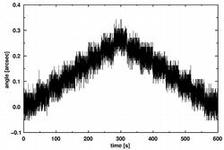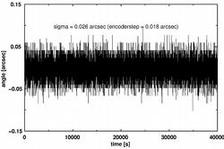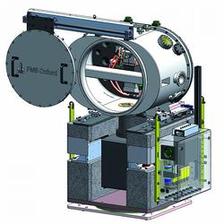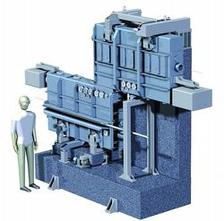Figure 2a: Measured step resolution of the directly driven Bragg angle axis. Servo encoder angle read-out vs. step rotation of the Bragg axis (two encoder steps each, equally spaced in time), bidirectional motion.
The preservation of the exceptional beam quality provided by PETRA III undulators calls for ambitious technical solutions in the realization of the optical components in the beamline. Liquid nitrogen cooled X-ray monochromators with a novel Bragg angle drive mechanism and other challenging technical options were developed. The monochromator design also accounts for the “canted undulator” geometry, i.e. two beamlines with a narrow separating angle, which imposes additional constraints.
Direct drive monochromators
The high heat load X-ray monochromator concept is based on a central rotation axis and a fixed-exit beam. The Bragg axis is directly driven by an ex-vacuo 3-phase torque motor controlled by a high resolution incremental encoder system in-vacuo. The drive is connected via a ferrofluidic rotary feedthrough which also guides the liquid nitrogen tubing for the crystal cooling. There are no further couplings or gearboxes. This rigid drive train provides excellent stability, reproducibility, and resolution of the Bragg angle setting (Fig. 1). Eight of these systems ( and further three similar systems ) are installed at PETRA III beamlines.
The Bragg drive system revealed excellent stability of 0.026 arcsec (RMS) with a numerical resolution of 0.018 arcsec/step (Fig. 2), which is equivalent to 200000 encoder steps/degree. The read-out of the internal encoder was in agreement with an independent external measurement using a high-resolution autocollimator. Another special design feature is a piezo-driven z-axis of the second crystal, additional to the usual pitch and roll adjustments (both piezo-driven). Following a coarse alignment by stepper motors, this new degree of freedom allows a fine tuning of the vertical beam exit position while keeping the maximum of the rocking curve.
At PETRA III, the space available for the monochromator system depends on its position from the source and the type of the beamline, i.e. single or canted undulators. In the latter case, one of the undulator beams may pass through the other system requiring a jacket pipe surrounding the second beam pipe (Fig. 3).
Large Offset Monochromator
There are several concepts to arrange two canted undulator beamlines in order to provide maximum flexibility for each. One solution is to keep the angular separation of 5 mrad between the photon beams in the horizontal plane and separate the beam paths in the vertical plane. The most sophisticated system at PETRA III is a Large Offset Monochromator (LOM, Fig. 4) which vertically displaces the monochromatic beam by 1.25m resulting in a beam height of 2.65m at the experiment which resides on an elevated platform above the other beampath.
The large vacuum system consists of two rectangular vessels supported by a granite base. Inside each vessel, a crystal system is travelling along a high-precision linear rail to maintain the fixed beam exit. All degrees of freedom of the two crystal systems are controlled by stepper motors and multi-axes piezo-driven tables in order to maintain the optimum rocking curve and beam position under all operation conditions. Additionally, an integrated laser based alignment system will be used to stabilize the monochromatic beam independent of the X-ray beam monitors.









